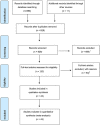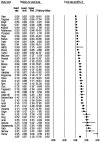Prevalence of Borderline Personality Disorder in University Samples: Systematic Review, Meta-Analysis and Meta-Regression
- PMID: 27171206
- PMCID: PMC4865108
- DOI: 10.1371/journal.pone.0155439
Prevalence of Borderline Personality Disorder in University Samples: Systematic Review, Meta-Analysis and Meta-Regression
Abstract
Objective: To determine pooled prevalence of clinically significant traits or features of Borderline Personality Disorder among college students, and explore the influence of methodological factors on reported prevalence figures, and temporal trends.
Data sources: Electronic databases (1994-2014: AMED; Biological Abstracts; Embase; MEDLINE; PsycARTICLES; CINAHL Plus; Current Contents Connect; EBM Reviews; Google Scholar; Ovid Medline; Proquest central; PsychINFO; PubMed; Scopus; Taylor & Francis; Web of Science (1998-2014), and hand searches.
Study selection: Forty-three college-based studies reporting estimates of clinically significant BPD symptoms were identified (5.7% of original search).
Data extraction: One author (RM) extracted clinically relevant BPD prevalence estimates, year of publication, demographic variables, and method from each publication or through correspondence with the authors.
Results: The prevalence of BPD in college samples ranged from 0.5% to 32.1%, with lifetime prevalence of 9.7% (95% CI, 7.7-12.0; p < .005). Methodological factors contributing considerable between-study heterogeneity in univariate meta-analyses were participant anonymity, incentive type, research focus and participant type. Study and sample characteristics related to between study heterogeneity were sample size, and self-identifying as Asian or "other" race. The prevalence of BPD varied over time: 7.8% (95% CI 4.2-13.9) between 1994 and 2000; 6.5% (95% CI 4.0-10.5) during 2001 to 2007; and 11.6% (95% CI 8.8-15.1) from 2008 to 2014, yet was not a source of heterogeneity (p = .09).
Conclusions: BPD prevalence estimates are influenced by the methodological or study sample factors measured. There is a need for consistency in measurement across studies to increase reliability in establishing the scope and characteristics of those with BPD engaged in tertiary study.
Conflict of interest statement
Figures


References
-
- Norling DC, Kim S. Borderline Personality Disorder In Thomas JC, Hersen M, editors. Handbook of Clinical Psychology Competencies. New York: Springer; 2010.
-
- Grant BF, Chou SP, Goldstein RB, Huang B, Stinson FS, Saha TD, et al. Prevalence, correlates, disability, and comorbidity of DSM-IV borderline personality disorder: Results from the wave 2 national epidemiologic survey on alcohol and related conditions. J Clin Psychiat. 2008; 69: 533–545. - PMC - PubMed
Publication types
MeSH terms
LinkOut - more resources
Full Text Sources
Other Literature Sources

